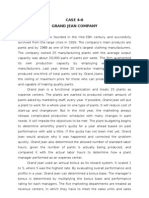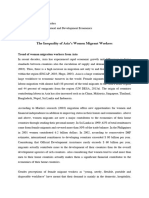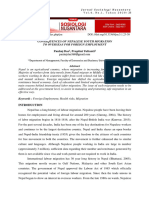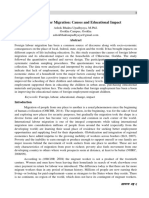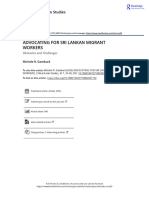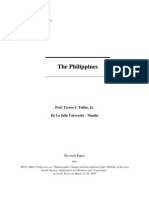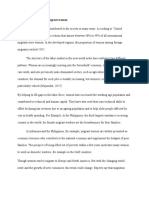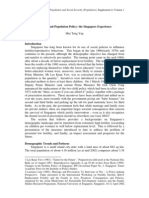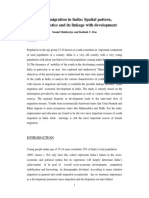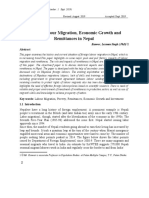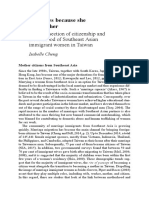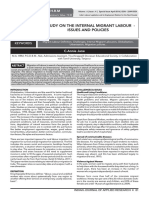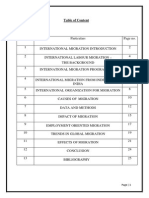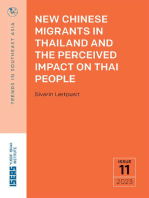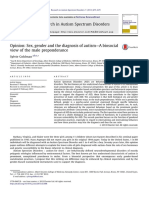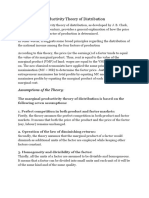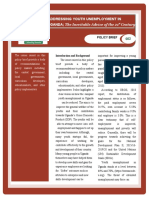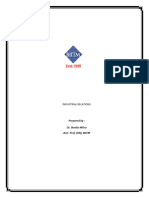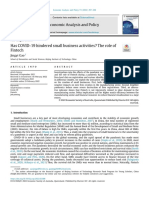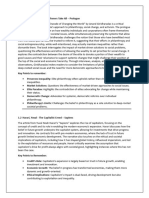Filipino Domestic Workers in Singapore: Impacts On Family Well-Being and Gender Relations
Filipino Domestic Workers in Singapore: Impacts On Family Well-Being and Gender Relations
Uploaded by
Milo DueCopyright:
Available Formats
Filipino Domestic Workers in Singapore: Impacts On Family Well-Being and Gender Relations
Filipino Domestic Workers in Singapore: Impacts On Family Well-Being and Gender Relations
Uploaded by
Milo DueOriginal Title
Copyright
Available Formats
Share this document
Did you find this document useful?
Is this content inappropriate?
Copyright:
Available Formats
Filipino Domestic Workers in Singapore: Impacts On Family Well-Being and Gender Relations
Filipino Domestic Workers in Singapore: Impacts On Family Well-Being and Gender Relations
Uploaded by
Milo DueCopyright:
Available Formats
FOR PARTICIPANTS ONLY ESID/EGM/INF.
12 14 August 2003
ECONOMIC AND SOCIAL COMMISSION FOR ASIA AND THE PACIFIC Ad Hoc Expert Group Meeting on Migration and Development 27-29 August 2003 Bangkok
Filipino domestic workers in Singapore: impacts on family well-being and gender relations*
(Item 8(b) of the provisional agenda)
This paper was prepared by Ms. Shirlena Huang, Department of Geography, National University of Singapore; Ms. Brenda S. A. Yeoh, Department of Geography, National University of Singapore and Asian MetaCentre for Population and Sustainable Development Analysis; and Ms. Maruja M. B. Asis, Scalabrini Migration Center, Quezon City. The Views expressed in this paper are those of the authors and do not necessarily reflect those of the United Nations. This paper has been issued without formal editing. The designations employed and the presentation of the material in this paper do not imply the expression of any opinion whatsoever on the part of the Secretariat of the United Nations concerning the legal status of any country, territory, city or area, or of its authorities, or concerning the delimitation of its frontiers or boundaries.
Introduction: Labour Migration in Southeast Asia
International migration is part of a transnational revolution that is reshaping societies and politics around the globe. (Castles and Miller, 1998: 5) Across the globe, the increased volume, accelerated pace and evolving forms of transnational migration have led Castles and Miller (1998: 3) to label the beginning of the twenty-first century an age of migration. The International Labour Organization expects these trends to continue driven by rapid declines in fertility in the more advanced regions, higher rates of urbanisation, technological change, and the forces of economic integration and globalization (www.ilo.org; accessed 12 July 2003). According to the Population Division of the United Nations, there are about 175 million1 international migrants (United Nations, 2002, as cited in IOM, 2003: 4); approximately a quarter are legal labour migrants (Castles and Miller, 1998: 162) (estimates of unauthorized or irregular migrant workers are not available).
International labour migration within and from Asia including Southeast Asia was relatively limited in the post-World War II period up to the 1970s (Skeldon, 1999). With the petroleum boom of the 1970s, however, the Middle East became a major destination for labour migrants from all parts of Asia, including the Philippines, Indonesia and Thailand (Castles and Miller, 1998). Since the 1980s, there has been both a manifold increase in the level of labour migration within and from Asia, as well as a diversification of both destination and source countries. Labour migration continued to grow through the 1990s, hardly affected by the Asian financial crisis (Guo and Iredale, 2003: 79) although recent reports suggest that the demand for sectors such as foreign domestic workers may be slowing down
This number includes refugees and displaced persons, but not irregular migrants. International migrants represent some 2.9 per cent of the world's population of 6.057 billion (as of 2000).
as the Asian financial crisis is prolonged (The Straits Times, 14 July 2003).2 Today, Southeast Asia is home to several of the worlds largest labour surplus nations Indonesia and the Philippines and two large labour receiving countries Singapore and Malaysia, while Thailand is both an importer and exporter of migrant labour. Both the former are among the worlds largest exporters of overseas
workers, among which unskilled female overseas contract workers (OCWs) in the form of domestic workers3 comprise a significant component.
Indeed, the feminization of migration is a trend that has characterized the latter half of the twentieth century. Almost half 48 per cent of the world's international migrants are women, who are moving not just as spouses or family members, but also as independent migrants (IOM, 2003:5). Their increasing
participation in all types of migration, but particularly as labour migrants, is expected to continue into the second decade of the twenty-first century (Castles and Miller, 1998: 9). The emergence of large-scale transnational female labour
migration from Southeast Asian nations is recent (only since the 1960s) and both a cause of and a response to the growth in demand for labour in the service and entertainment industries of the Middle East and Asia (Wong et al, 2003), particularly in domestic work. In recent years, female labour migration in many Southeast Asian countries has grown exponentially and in some countries, overtaken the level of their male counterparts. For example, between 1994 and 1999, Indonesias female OCWs (most who left to work as domestic workers in the Middle East; Singapore; and Hong Kong, China) outnumbered males by almost two and a half times (Hugo, 2002: 17). In the Philippines, the number of newly hired
For example, it was reported that the number of Filipino domestic workers in Hong Kong, China dropped from 140,4000 at the end of March 2003 to 133,570 in late May 2003, while in Taiwan Province of China, the number of foreign domestic workers now stands at only 7,000 (down from a peak of 50,000 in 1992) (The Straits Times, 14 July 2003). 3 While domestic workers are officially classified as unskilled, it has been noted that such a label is a questionable one not only because many women with qualifications and experience in skilled occupations take up positions as foreign domestic workers for economic reasons, but also whether domestic skills (such as childcare, cooking and cleaning) should be totally disregarded (see, for example, Huang and Yeoh, 1998; Guo and Iredale, 2003; Huang and Yeoh, 2003).
Filipino OCWs has been female-predominant since 1992, with seven in ten of all new hires in 2002 being female (www.poea.gov.ph; accessed 11 July 2003).
From the perspective of the countries of origin, female labour migration has been a mixed blessing. If the measure of things was economic and at a macro level, there is consensus among countries of origin of the benefits of labour migration and migrants remittances are acknowledged as a pillar of the respective economies. The Philippines has perhaps gone the farthest in recognizing this, bestowing on migrant workers the sobriquet of mga bagong bayani (new heroes) for their remittances that have buoyed the countrys economy since the 1970s.4 However, the economic windfall from labour migration is dimmed by fears and anxieties about unsettling social costs. The concerns raised over the migration of women have been more alarmist than those raised over the migration of men. Far from the journey of achievement that migration signified in the migration of men in some Southeast Asian cultures in the past (Aguilar, 2002; Margold, 2002), female labour migration in contemporary times is rife with risks and dangers. In particular, the invisible, isolated, unprotected, and lowly regarded work that migrant women do domestic work and entertainment5 continues to raise the specter of abuse and exploitation.6 Despite the highly regulated nature of migration in the region, the regulations set up by receiving nations have served more as mechanisms of
In the Philippines, the contributions of migrants to the country are highlighted by such gestures as holding National Migrants Day (held every June 7, in commemoration of the signing of the Migrant Workers and Overseas Filipinos Act of 1995), presenting awards to outstanding Filipino migrants (one of the awards is known as Bagong Bayani), and welcoming returning migrants during the Christmas holidays. For the past 17 years, the Catholic Church in the Philippines has also celebrated National Migrants Sunday, which is held every first Sunday of Lent. Migrant women are also recruited in the manufacturing sector e.g., Taiwan Province of China. However, even in Taiwan Province of China, the demand for domestic workers and caregivers has been consistently rising, while the demand for factory workers is subject to economic fluctuations. Although accounts of women who worked in factories indicate that working conditions are not necessarily better (e.g., Asis, 2001), they are not as invisible or isolated as women in domestic work and entertainment. 6 The problems encountered by migrant women begin from pre-migration through the other phases of the migration process. Prior to migration, women may be abused arising from the illegal exaction of fees or confinement in the houses of recruitment agencies/training centers. In the country of destination, long working hours, non-payment or delay in wages, no days off and physical/verbal/sexual abuse are conditions migrant women may find themselves in. Upon return, migrant women may be abused by airport officials and/or unscrupulous transport operators.
5 4
surveillance than as protective measures (see Chin, 2003; Huang and Yeoh, 2003; Lan, 2003 for a discussion of the situation in Malaysia, Singapore and Taiwan Province of China respectively). Programmes and mechanisms including the
regulation of recruitment agencies in the home countries, pre-departure information and training programmes, deploying labour and welfare officers in countries of destination, and establishing workers resource centres in major countries of destination established by sending governments to minimize the risks of female migration have also proved minimally effective or temporary. Aside from the difficulty of stopping migration, given the social networks and the migration industry that are already in place, sending states are held hostage by remittances, the loss of which represents a major economic problem, especially in times of economic crisis, when the unexpected return of labour migrants could worsen domestic unemployment.
There is thus a tension between what is good for the country versus what is good for the families or individuals, between economic gains and social costs, between short-term benefits and long-term impacts. In Indonesia, the Philippines and Sri Lanka, the departure of women to toil as domestic workers has come to represent their economic subjugation to other countries. The association of these countries as nations of housemaids has given rise to a sense of shame, particularly on the part of the middle and upper classes (see for example, Aguilar, 1996; 2000 for the discussion on the transnationalization of shame of the OCW phenomenon in the eyes of elite, and middle- and upper- class Filipinos). Sending states have also been faulted by migrant NGOs for neglecting or relegating the protection of the rights of their nationals especially women migrants in the name of economic gains (e.g., Beltran and de Dios, 1992; Pudjiastuti, 2003; Saroor, 2003). The tugof-war between economic gains versus social costs is summarized in the following observation:
I guess the price paid for overseas employment is sometimes high it separates families, it breaks them up sometimes and people can get maltreated. In fact, some have died already. We cannot
close our eyes to that but we cannot close our eyes either to the fact that if one million people come back to this country and could not find jobs, wed all be in trouble (Sto. Tomas, 1996: 226).7 From the perspective of receiving countries, foreign domestic workers are also regarded as a mixed blessing or even a necessary evil. On one level, the availability of a pool of low cost, compliant labour has been a ready-made solution to these host societies burgeoning middle class and their demand for labour substitutes in the reproductive sphere. Given that most locals in receiving countries like Singapore; Malaysia; Hong Kong, China; and Taiwan Province of China are no longer willing to take on paid domestic work, the shortfall has been filled by foreign domestic workers, thereby allowing women in host countries to enter and contribute to the formal waged economy. On another level, the presence of large numbers of foreign domestic workers has raised considerable concerns regarding the broader social impacts, foremost among which is the issue of weekend enclaves associated with the weekly gatherings of foreign domestic workers in public places in cities like Singapore (Lucky Plaza), Hong Kong, China (Statue Square) and Taipei (Chongshan North Road). Such gatherings are often perceived as a social nuisance, and places to be avoided by locals on the weekends because of the crowds and the noise. Though foreign domestic workers are generally invisible and marginalized in their host societies, when they are rendered visible by media reports in these receiving nations, such reports have tended to portray these migrant women in a negative light, often as a danger to the moral fabric and/or public health aspects of their host societies (see, for example, Yeoh et al, 1999a; Chin, 2003; Huang and Yeoh, 2003; Lan, 2003). According to Chin (2003: 64), the circulation of these stories elicits fear and resentment that overlays or fragments public empathy and support for the rights of migrant women domestic workers in particular, and migrant labour in general.
Patricia Sto. Tomas is presently the Secretary of the Department of Labour and Employment; she was head of the Philippine Overseas Employment Administration from 1982 to 1987.
Thus, just as with the sending countries, there exists a tension between the economic benefits and social costs, and between short-term versus long-term impacts with respect to the presence of foreign domestic workers. Despite these broader concerns, while focus in the literature has often foregrounded the vital role that female domestic workers play in maintaining the reproductive spheres of their employers all over the world (see for example, le Roux, 1999; Pratt, 1999; Tam, 1999; Parreas, 2001), there appears to be little academic debate on how foreign domestic workers affect the dynamics of the families for whom they work. It is the interrelationships between labour migration and the institution of the family in both sending and receiving countries to which we now turn our attention, and which will be the focus of the rest of the paper.8 Labour Migration and the Asian Family in the 21st Century
Given the increasingly feminized face of migration in the region and womens key role in the typical Asian family, it is remarkable that there has been only limited work on the social dimensions of migration in Asia, and an even greater neglect of the family as a unit of analysis (see Hugo, 2002). The paper stresses the need to train analytical lens and level of focus not just on social impacts, but more importantly, on the family. It is contended that this is crucial given the way the evolution of novel forms of migration processes over the last two decades have rapidly transformed the lives of millions of families while inextricably linking the fates of societies and states together. One such new category of
international migrant that has emerged is the transmigrant whose life is affected
We draw on data from several sources to make sense of the changing contours of family relationships in the region as mediated by migration. The first is a series of in-depth interviews conducted with 15 Singapore employers and 30 foreign domestic workers in 1995-96. The second is a set of in-depth interviews conducted in 2000-2001, of Filipino domestic workers in Singapore and the Philippines (Ilocos Norte and Iloilo): 9 return migrants, 8 family members of return migrants, 13 family members of current migrants, and 6 migrants currently working in Singapore. In the absence of empirical studies on the social impacts of international labour migration, we situate these narratives vis--vis the concerns articulated in the media by government officials, analysts and the general public.
by, and spans between, events in both his or her place of origin [usually related to matters of employment] and his or her place of arrival [largely related to family ties] (Lima, 2001: 78). This phenomenon has in turn created transnational
families, both nuclear and extended, [which] are dispersed across international borders, and [whose] members tend to spend periods of time in one or the other country and for a variety of reasons. Their geographical location is fluid [and] they develop their work trajectories and projects in each of the two countries (Lima, 2001: 78). There is in fact a growing literature recognizing the emergence of transnational families as a strategic response to the rapidly changing social, economic and political conditions of a globalizing world (see, for example, Parreas, 2001; Bryceson and Vuorela, 2002; Ho, 2002). 9
It must of course be acknowledged, as Ho (2002: 145-146) has pointed out, that families with members located in two or more nations over extended periods, but who retain close links with their homelands, are not a new concept. The multilocale family was certainly characteristic of many migrant Asian families in the 19th and 20th centuries; in colonial Singapore, for example, this was a normal aspect of life for many Chinese and Indian men who had migrated to the colony leaving behind wives and children who may or may not have joined them later. However, at least three features distinguish todays transnational family setup from the multilocale family of the past.
First, todays telecommunications and transportation technologies support the frequent and almost instantaneous yet low-cost communication and maintenance of ties among family members (through telephone calls, short messaging services (SMSs), money transfers, mailing of care packages, air flights home, etc.), something absent in the past. It is these constant links that are significant in creating a transmigrant whose life is simultaneously affected by events taking place
9
Although different authors have slightly varying meanings in using the term transnational family, there is general agreement agree that the distinguishing feature of the transnational family is the fact that while its core members are distributed in two or more nation-states, they continue to share strong bonds of collective welfare and unity.
at the places of origin and arrival, as opposed to simply an international migrant in the past whose everyday life was mainly affected by events at the destination. Similarly, transmigrants are able to continue to play a role in the lives of their families left behind.
A second key difference between the past and present is the fact that for many, it is now the women those who are socially regarded and accepted as the primary caregiver of the family and upholders of Asian family values and traditions (Stivens, 1998) who are leaving their families behind. More commonly, the woman migrates alone to work overseas, but in some cases, both husband and wife may work abroad, leaving the children behind. While the implications of this for the familys economic well-being are quite clear, the social, emotional, and psychological aspects of such a care drain (Hochschild, 2002) are certainly more ambivalent. The latter are often tied not only to how effectively female migrants maintain their transnationational circuits of affection, caring and financial support10 (whether through communications or travel) to keep their families physically and emotionally intact during their absence, but also to the extent to which family as well as gender roles and identities can be reconfigured to fill the vacuum left by the women.
Third, as Yeoh et al (2000:6) have identified, is the fact that family relations stretched across distance today have to be managed in the context of the nation-state framework, which is predicated on the idea of a primary belonging to one society and a loyalty to just one nation-state (Castles, 2000: 8). But, as Lima (2000), Ho (2002) and Lam et al (2000) have shown in various geographical contexts (Mexico-United States; Hong Kong, China-New Zealand; and MalaysiaSingapore, respectively), the transnational family is able to transcend such differences and maintain a sense of multiple and multi-localized belonging.
10
A phrase adapted by Yeoh et al (2002: 6) from Hondagneu-Sotelo and Avilas (1997) term circuits of affection.
With the growing phenomenon of the transnational family, an increasing number of scholars of migration are calling for a family perspective on migration (see for example, Yeoh et al, 2002; Hugo, 2002; Asis, 2003) because of their mutually constitutive effects on each other. The argument is that:
on the one hand, migration [is] a life-changing decision a lifechanging decision and process is deeply embedded, and must be understood, in the context of family norms, relations and politics; and on the other (trans)migratory moves often reconstitute the [family] in ways which are sometimes destabilizing, sometimes affirming (Yeoh et al, 2002:1). Not surprisingly, these calls are more often than not associated with work on female labour migration. While both male and female migration may contribute equally to their families and nations economic well-being, it is female migration that significantly impacts the changing gender roles and relations and family wellbeing in the countries of origin and destination. While women are expected to and do naturally take up the slack when male members of their families migrate, research has shown that the transfer of roles from women to men is not automatic as gender roles tend to be sticky (Espiritu, 2002). More often than not, it is the other female members of the family left behind who are pressed upon to fill the vacuum left by the migrant, regardless of whether the latter is male or female. In the receiving countries, the female labour transmigrant has a far greater likelihood of impacting gender roles and relations and family well-being, given their work as domestic workers (and entertainers) in the receiving nations. While there is some work on this aspect on the family left behind in the migrants homeland (see for example, Battistella and Conaco, 1998; Wille and Passl, 2001; Parreas, 2002 for Southeast Asia; and INSTRAW AND IOM, 2000 for South Asia), little has been done to look at the impact of female labour migration on the families in the receiving nations.
The next section of the paper explores the pains and gains of female labour migration on family well-being (in terms of its economic and emotional
implications) and gender roles and relations of the migrant domestic workers (both current and return migrants), their family members, and the families of their employers. More specifically, the paper focuses on the migration of Filipino
women who seek work as domestic workers in Singapore, a city-state where one in seven households employs a foreign domestic worker.
Circuits of Affection and Care Chains: Female Labour Migration from the Philippines to Singapore
3.1
The View from Sending Countries: A Focus on the Philippines Of the various social changes unraveled by labour migration, those
impinging on the institution of the family in the sending countries are generally regarded as the most unsettling. While much more work on the negative
consequences associated with the long absences of migrants has focused on male than female migrants, two types of impact that migration has on the family left behind may generally be distinguished: first, adjustment to the long-term absence of family members; and second, adjustment to the influences of the newly acquired money, goods, ideas, attitudes, behavior and innovations transmitted back by the movers (Hugo, 2002: 20). More specifically, Yeoh et al (2002: 5) contend that issues of material welfare pale in comparison to the social and emotional consequences confronting left-behind families, particularly dependent members; however, they also note that the social and emotional costs of migration borne by left-behind family are not predetermined. Most policy makers and scholars of
migration are beginning to highlight the more significant problems in general as well as those related to the family, arising out of womens rather than mens migration. As the Philippines current Secretary of the Department of Labour and Employment has observed:
Critics also cite [migrations] immeasurable damage to national returning workers in rejoining bewildered sense of nationhood on
social costs to the family, its dignity, the problem faced by mainstream society and the the part of many Filipinos.
10
With the increase in the number of female workers deployed, women groups warn against overseas employments tendency to systematically fragment labour in a way that is extremely disadvantageous to women. For them, the greatest costs of overseas work are its toll on family life and the denigration of the workers personal dignity (Sto. Tomas, 2002: 167-168). In the Philippines, while male migration to the Middle East in the 1970s raised concerns that the departure of fathers and husbands would weaken the family, this was still within the mold of men needing to seek greener pastures to support their families. Female labour migration, particularly the migration of
married women with children, is a transgression of the expectation and ideal of a stay-at-home-mother/wife upon whose unpaid labour the reproduction of social life is anchored. However, families of migrant workers have to come to terms with market forces, i.e., the demand for reproductive workers in the more affluent countries. Interviews with family members of migrant workers have also expressed the view that if a family member must seek work abroad, they would rather prefer that the men leave, not the women especially, mothers. In the Philippines, the departure of mothers, who are regarded as the ilaw ng tahanan (the light of the home) the complement and the foil to the father who is the haligi ng tahanan (the pillar of the home) is generally perceived as imperiling the family, and the childrens welfare in particular (Parreas, 2002; Asis, Huang and Yeoh, 2002). As the light of the home, mothers are perceived to hold the family together, hence their physical presence is deemed vital to the family.
If male migration had expanded womens roles (but without uprooting women from their natural realm, the home), female migration has reconfigured many aspects of the family. Gender relations have been turned upside down, with women becoming the main breadwinners thereby intruding into mens turf. The reversal of gender roles has led to redefinitions of masculinity as fathers, brothers and husbands become secondary earners and, in some instances when female relatives are not available or able to take over, as husbands assume the role of
11
caregivers/mothers. Significantly, interviews suggest that such reversals do not appear to have threatened the mens standing in their families. For example, although Andy11 took him about a month to adjust after his wife Edna left for Singapore, taking over his wifes chores in the house was not really a problem; as he stated, I feel good because I have [something to do] (laughing), even if I wash clothes, cook. While he acknowledged that the
remittances from Edna mean so much these went into the construction of a bedroom, the childrens school expenses and food he still regards himself as the head of the family and insists that Ednas being in Singapore has also not changed her role in the family. According to Andy, Even if shes there, she still says what she likes to say, and also she says what she likes for the children. Similarly, the other men who were interviewed claimed that they felt relatively comfortable in their roles as main caregivers to their children.12 Interestingly, informal
conversations with other community members (non-migrants) hinted at some problematic aspects that left-behind husbands did not readily acknowledge or talk about.
Concerns about the stability of marriages in relation to male migration also exist for the migration of women. Related to this is the perception that when it is the women who leave, men cannot fully substitute for the mother, regardless of how willing they are to take on the roles of their migrant wives. As such, the familys well-being, especially the childrens, is jeopardized. The present research supports Battistella and Conacos (1998) study which found that for young children, the absence of mothers has some association with their poorer performance in school and difficulties in social relationships. For example, Jun (whose wife Hilda used to work in Singapore) noted that the only negative thing that had resulted from Hildas
11 12
All respondents are referred to by pseudonyms. The experience of taking care of children and things domestic has led the men to appreciate the domestic work that women do. One full-time caregiver-husband in our study mentioned that while he has become used to his role, he would also like to have some time off to engage in other pursuits.
12
two-year absence was the delay in their sons schooling as a result of them playing truant without him knowing about it during much of this time.
While the children can often cope with and rationalize away their mothers absence in the short term, the long-term impacts may be more ambivalent, especially if the mothers absence results in the breakup of the marriage. It is clear that the emotional toll exacted on members of the transnational family is great. During the interview, the respondents expressed emotional display while talking about the difficulties of being away from their families. In the case of unmarried migrants, it was usually the parents who felt their daughters absence more than the siblings. Aware of the hardships their daughters experienced abroad, parents tended to express more longing for the family to be together. In the case of married migrants, most migrants (and their husbands) often assessed the economic benefits of their (wives) migration on their families as being a necessary price to pay for improving the lives of their families, and almost all the respondents who were interviewed felt that their earnings had been invested wisely. However, the children often had a greater struggle to see likewise. For example, Jenny (aged 26 years) insisted that she and her siblings (aged 10 to 16 at the time her mother Anna left to work in Singapore) understood their mothers departure as something that she had to do so that they could finish college. However, to Daniel (aged 17 years), the material gains of his mothers sacrifices working as a domestic in Singapore in no way makes up for the toll it has wrought in his family and his life and blames the breakup of his parents marriage on his mothers absence. He argued: If she didnt go there, maybe our family would still be complete. Even if we dont have money, but at least we are complete.
Migrant mothers themselves also often bear doubts and guilt about having to leave their children. To cope, some migrant mothers deny the pain, or transfer their love and care towards their charges as if they were their own children; most, however, try to assuage the pain of their absence and separation from their families and children by buying expensive gifts, and continue their mothering role from a
13
distance by keeping in touch with the family and the children as frequently as possible. Many of the women and family members referred to how this has been made easier and more accessible by developments in information and communications technology in recent years, with SMS being a highly favored method as it allowed cheap and almost instantaneous exchanges. But most struggle with binational motherhood, and realize the inadequacies of transnational mothering. In the words of Alice who has worked in Singapore for 12 years to put her children through school:
Sometimes I regret that I have neglected my duty to my family, especially my children, they grow up without me. Sometimes I have to spend $60 on a phone call. ... They must tell me what they feel. I must tell them what I feel. Being a mother, we have to discipline our children whether far or near. ... It is not easy to be a mother far away, you know. On the whole, research findings indicate that families have adjusted to the migration of family members, including the migration of wives and mothers (e.g., the studies on the Philippines, Indonesia and Thailand in Wille and Passl, 2002). Research to date has suggested that the extended family has helped maintain the transnational family by filling the void left by migrant members. There are indeed some problematic areas cases of infidelity (by the spouses left behind and migrants), delinquency, or children dropping out of school, emotional estrangement between mothers and the children left behind but research has yet to establish the magnitude of these problems.13 Nor has there been a close examination of how families have managed to become resilient in the face of migration.
3.2
The View from Receiving Countries: A Focus on Singapore As already noted, much of the work on female domestic workers in
receiving countries has focused on their broader economic and social impacts on
13
Similar problems have also been found in Indonesia including marital strain, infidelity and second spouses leading to abandonment and divorce; child rearing problems (including impeded social and psychological development as well as emotional and mental disorders); and lack of support for the aged (Hugo, 2000: 23-24; 34-36).
14
their host nations, their marginal status as workers in gender segregated markets, and their vulnerability to discrimination, exploitation and abuse. Arising from this, it has often been the employer-employee relationship that has been the centre of attention in terms of analyzing the impact that female domestic workers have on their employing household. Indeed, debates on the effects of having foreign
domestic workers on the family roles and relations of their employing household are much less common in academic and policy analyses than in the media (see for example, Parents by proxy: Moms and dads learn to parent from the office in The Asian Wall Street Journal, 10 December 1999; Entrepreneurs taught not maid in The Straits Times, 15 February 2002).
In Singapore, concerns of having live-in foreign domestic workers and their impact on the family have focused on three familial roles: first, their impact on the lives of their female employers; second, their impact on the children they care for; and third, their potential impact on the male members of their employers households. More generally, of course, any impact on the life of one member of the family has repercussive impacts on the rest of the family.
Singapores initial rationale for allowing foreign domestic workers into the country in 1978 was primarily economic: it needed women with higher skills to remain in the workforce [to ease the countrys labour shortage in this area] and to have children (The Straits Times, 6 March 1992). This same economic logic now works to benefit individual families as many women in Singapore are now able to participate in the formal economy and have dual-income households as the presence of foreign domestic workers frees them from their reproductive chores and participate. Earlier research has established that many women in Singapore who employ foreign domestic workers would have to quit their jobs should the latter become unavailable (Huang and Yeoh, 1996). More recently, government proposals to raise the maid levy14 in
14
All employers of foreign workers in Singapore have to pay a monthly levy to the government. This levy varies by sector and currently stands at S$345 per month. The levy works to control the demand for contract migrant workers, as well as to ensure that their wages reflect labour market conditions and not simply the marginal cost of hiring foreign workers (Low, 1995: 753).
15
Singapore (The Straits Times, 3 November 2002):
has drawn hardship tales and protests. This is inevitable, as families which have maids look at only the aggregate cost and almost never examine the question of need. It is not known how many of the households which employ the 140,000 foreign maids working here have young children who need full attention. These families cannot dispense with maids as both husband and wife work to pay the mortgage, above all other bills. Beyond the economic benefits of a second income from the wifes participation in the labour force, foreign domestic workers also impact the family roles and relations of their female employers in very real as well as intangible ways. For many, the price paid for a domestics services is an investment towards enhancing their and their families quality of life. For example, one of the interviewees, April (a full-time manager with two young children) said that she wanted to go back to work after the birth of her second child because she felt that she needed the adult company. Employing a foreign domestic worker allowed her to fulfil this need. Other respondents noted that having a full-time domestic worker relieved them of their basic household tasks and allowed them to spend more time with their husbands and their children (see Yeoh et al, 1999). A recent survey (done in 1999-2000 in which two of the authors of this paper participated) also found that when members of Singapore families are involved in transnational work either through frequent and often prolonged business trips, or on overseas postings foreign domestic workers are more frequently called upon to take care of domestic matters when it is the wife who travels compared to the times the husband is away. As pointed out earlier, the practice of transferring duties of the reproductive sphere from one woman to another (rather than expecting husbands to help out) simply reinforces womens existing gender roles and identities as embedded in domesticity and motherhood.
It would appear that the presence of foreign domestic workers contributes to both the economic and emotional well-being of their employing families in receiving nations. However, one should not neglect the evidence showing that female
16
employers have to negotiate their own concerns about entrusting their children and homes to someone else. Although relieved from the physical stress of domestic chores, female employers are apt to worry about what their domestic workers are up to while they are at work. Additionally, for employers who are mothers of young children, there may also be the emotional and mental struggle of maternal guilt of leaving the children to the care of someone else, and which present its own set of ambivalences and stress for these women (see Yeoh et al, 1999).
Thus, a common concern among the employers were the short and especially the long term influences of foreign domestic workers have had and would have on their childrens value systems (see Yeoh et al, 1999). The government first raised the issue some fifteen years ago with the question of how a future generation of Singaporeans who grow up used to having maids to perform all the household duties would turn out (then Minister of Labour, Lee Boon Yang, cited in The Straits Times, 2 February 1988). Since then, the issue which has come to be labeled the maid dependency syndrome has repeatedly been debated in the popular media, and a generation that has grown up with foreign domestic workers has already realized the impact of having a domestic worker around to pick up after them as a child. As one member of the public noted: As an adult now, I see the consequences of this upbringing [i.e. having a foreign domestic worker at home until the writer was 14] very clearly in my life patterns my surroundings are invariably piled high with items not put away] (The Straits Times internet chatsite, 24 October 2000).
According to some, the consequences of the extensive employment of foreign maids in the country have been children who are very dependent on maids, leading to worries about how the youth of Singapore will turn out and its implications for the future leadership of Singapore (The Straits Times, 29 July 2002). In fact, the lack of entrepreneurial spirit in Singapore has also been attributed to the presence of foreign domestic workers and doting parents (The Straits Times, 15 February 2002). However, others have argued that foreign domestic workers must be seen as a welcome resource in two-income families and as long as parents continue their
17
parenting duties by teach[ing] their children to be self-reliant employing maids does not necessarily lead to over-reliance on them (The Straits Times, 25 June 2000).
While it is the women and children rather than the men of the family that usually have more to do with the foreign domestic worker, concerns also exist relating to the potential role that a live-in female domestic worker could play in breaking up the family by compromising circumstances between the domestic worker and the male head of household or other male adult and even adolescent members of the family.15 Such man-maid problems a term coined by
Singapores main English daily newspaper The Straits Times include both molestation of foreign domestic workers as well as cases of willing sex on the part of both parties. While the former are usually reported by the victims (The Straits Times, 9 January 2001) or their female employers (The Straits Times, 27 August 2002), the latter are usually calls for help from wives whose husbands had run off with their maids (The Straits Times, 9 January 2001).
Having a live-in domestic worker may be the cause of additional marital stress for some. One employer recounted how she had emerged from her bedroom late one night and caught her 23-year-old foreign domestic worker of three months:
parading her very sexy body around the living room at midnight in a flimsy negligee with very little on underneath, while my husband was lying on the couch watching TV! And there I was all out of shape having just given birth two weeks ago! How long this had been going on, I dont know [because] I had been stuck in my bedroom with my baby since returning from the hospital. When I confronted my husband, he claimed that he did not realize that she was flaunting her body at him! He said he was too busy watching TV! Really did he expect me to believe him? I wanted to pack the maid off straightaway but could not do so because of my young son and the new baby. But I was angry with my husband for weeks.
15
Cases of molestation of foreign domestic workers in Singapore have been perpetrated by male family members as young as 14 years old.
18
To avoid such problems, another employer explicitly prohibited her foreign domestic worker from watching television after she (the employer) went to bed (usually at about 10 pm) because this would mean that the domestic would be alone with her husband who usually went to bed only after midnight. Thus, the presence of another female in the house, especially if she is young and attractive, can pose a challenge to her female employers womanhood. One husband quoted in the press (The Straits Times, 9 January 2001) observed that since Singapore families now had maids [who] waited on the men of the house hand and foot it may not be a bad idea for wives to shower a little TLC [tender loving care] on their husbands at times give him his water, serve him his rice.
In sum, while it may be said that foreign domestic workers have contributed to improving the economic and emotional well-being of Singapore families mainly by enabling female employers to transfer many of their duties in the reproductive sphere, concerns with respect to their impact on children and male household members may prove to be a source of stress and distress for some. While these broader issues are known, more research is needed to establish the extent of the pains and gains that employing a foreign domestic worker raises for the Singapore family and for gender roles and relations in Singapore.
Conclusions
Uneven economic development in Southeast Asian (and beyond) has led to intra-regional migration flows embodying not only transfers of productive labour but also, by now, a well-accepted trade in reproductive work. Feminized flows of paid reproductive labour have become a distinctive but regularized feature of increased mobilities and migrations in the region. This phenomenon has been fuelled by, and has in turn reinforced, changes in the practice of being family adapting to long distance mothering among Filipino migrant women; and adjusting to the presence of another woman in the house for Singaporean women are but two examples even though the ideal of being family continues to remain
19
a powerful and resilient concept in this part of the world. Even when the family is stretched transnationally, or when it becomes dependent on a foreign other for its day-to-day running, Southeast Asian women continue to see themselves as an integral part of the family, and vice versa, and to define their own life trajectories in relation to a clear concept of the family.
Given the significance of the mutually constitutive relationship between transmigration and the family, it is surprising that research on this front has been relatively thin. The limited work in this direction summarized in this paper has suggested certain possible costs and benefits accruing to the family in the context of transnational migration. More needs to be done to weigh the effects, not in a static fashion, but by taking into account the long-run impacts of migration on the family (hence the need for longitudinal studies); the gender and generational politics at work (for example, through examining the different points of view of family members with different subject positions, or by comparing the impact of male migration and female migration on the changing roles of left-behind members); and the inter-connections between multiple sites (for example, by comparing the impact of migration on gender relations in the source country with the way they are reconfigured in the destination country).
In view of the rapid social and economic changes in the Southeast Asian region, migration and family may serve as an essential pair of bifocal lenses that will assist us in arriving at a more nuanced understanding of human agency, everyday experiences and their complexities, as lived out against the broader economic, political and social canvas of a globalizing world (Yeoh et al, 2002: 9). Through the lenses of migration and the family, attention is directed to the murky, unquantifiable but very real emotional costs of an uneven world on families and their individual members. Given that the family is the basic unit confronting the market, the state, and the borderless impacts of globalization, the discourse on migration and development must also examine how families can be supported in their critical role in promoting the well-being of their individual members
20
Acknowledgements
The authors would like to thank the University of San Agustin Center for Research and Publications and the Social Action Commission of the Diocese of Laoag for their valuable assistance in the collection of data in Iloilo and Ilocos Norte, respectively. The authors also acknowledge funding support from National University of Singapore (NUS) Research Project R-109-000-008-112 and the Asian MetaCentre for Sustainable Development Analysis, NUS. Maruja Asis thanks the Meyer Fellowship and the Department of Geography, NUS, for research support. Shirlena Huang and Brenda Yeoh would also like to acknowledge the assistance of their research assistants, particularly Natalie Yap, in conducting the research in Singapore.
References
Aguilar, F.V. Jr. (1996), The Dialectics of Transnational Shame and National Identity, Philippine Sociological Review, 44(1-4): 101-136. Aguilar, F.V. Jr. (2000), Nationhood and Transborder Labour Migration: The Late Nineteenth Century from a Late Nineteenth Century Perspective, Asian and Pacific Migration Journal, 9(2): 171-198. Aguilar, F.V. Jr. (2002), Ritual passage and the reconstruction of selfhood in international labour migration, in F.V. Aguilar Jr. (ed.), Filipinos in Global Migrations: At Home in the World? Quezon City: Philippine Migration Research Network, pp. 413-451. Asis, M.M.B. (2001), The return migration of Filipino women migrants: Home, but not for good, in C. Wille and B. Bassl (eds.) Female Labour Migration in Southeast Asia: Change and Continuity. Bangkok: Asian Research Center for Migration, Chulalongkorn University, pp. 23-93. Asis, M.M.B. (2003), International migration and families in Asia, in Iredale, R., Hawksley, C. and Castles, S. (eds.), Migration in the Asia Pacific: Population, Settlement and Citizenship Issues, Cheltenham: Edward Elgar, pp. 99-117.
21
Asis, M.M.B., Huang, S. and Yeoh, B.S.A. (2002), When the light of the home is abroad: Female migration and the Filipino family, Paper presented at the 2002 IUSSP Regional Conference on Southeast Asias Population in a Changing Asian Context, Bangkok, Thailand, 10-13 June 2002. Battistella, G. and Conaco, M.C.G. (1998), The impact of labour migration on the children left behind: A study of elementary school children in the Philippines, Sojourn, 13(2): 220-241. Bryceson, D. and Vuorela, U. (2002), Transnational families in the twenty-first century, in D. Bryceson and U. Vuorela (eds.), The Transnational Family: New European Frontiers and Global Networks, Oxford and New York: Berg, pp. 3-30. Castles, S. and Miller, M.J. (1998), The Age of Migration: International Population Movements in the Modern World, 2nd edition, Basingstoke and London: Macmillan. Chin, C. (2003), Visible bodies, invisible work: State practices toward migrant women domestic workers in Malaysia, Asian and Pacific Migration Journal, 12(1-2): 49-73. Espiritu, Y.L. (2002), Filipino navy stewards and Filipina health care professionals: Immigration, work and family relations, Asian and Pacific Migration Journal, 11(1): 47-67. Guo, F. and Iredale, R. (2003), Gendered migration in Asia: Case studies of the Philippines, Indonesia and China, in R. Iredale, C. Hawksley and S. Castles (eds.), Migration in the Asia Pacific: Population, Settlement and Citizenship Issues, Cheltenham: Edward Elgar, pp. 79-98. Ho, E.S. (2002), Multi-local residence, transnational networks: Chinese Astronaut families in New Zealand, Asian and Pacific Migration Journal, 11(1): 145-164. Hochschild, A.R. (2002), Love and gold, in B. Ehrenreich and A.R. Hochschild (eds.), Global Woman: Nannies, Maids, and Sex Workers in the New Economy, New York : Metropolitan Books, pp. 15-30. Huang, S. and Yeoh, B.S.A. (1996), Ties that bind: State policy and migrant female domestic helpers in Singapore, Geoforum, 27(4): 479-493. Huang, S. and Yeoh, B.S.A. (1998), Maids and maams in Singapore: Constructing gender and nationality in the transnationalization of paid domestic work, Geography Research Forum, 18: 21-48.
22
Huang, S. and Yeoh, B.S.A. (2003), The difference gender makes: State policy and contract migrant workers in Singapore, Asian and Pacific Migration Journal, 12(1-2): 75-97. Hugo, G. (2002), Migration and the family in Indonesia, Asian and Pacific Migration Journal, 11(1): 13-46. International Research and Training Institute for the Advancement of Women, United Nations (INSTRAW) and International Organization for Migration (IOM) (2000), Temporary Labour Migration of Women: Case Studies of Bangladesh and Sri Lanka,Dominican Republic: Amigo Del Hogar. International Organization for Migration (IOM) (2003), World Migration 2003, Vol.2, IOM World Migration Report Series. Geneva: IOM. Lan, P.C. (2003), Political and social geography of marginal insiders: Migrant domestic workers in Taiwan, Asian and Pacific Migration Journal, 12(12): 99-125. le Roux, T. (1999), Home is where the children are: A qualitative study of migratory domestic workers in Mmotla village, South Africa, in J.H. Momsen (ed.), Gender, Migration and Domestic Service, London and New York: Routledge, pp. 183-194. Lima, F.H. (2001), Transnational families: Institutions of transnational social space, in L. Pries (ed.), New Transnational Social Spaces: International Migration and Transnational Companies in the Early Twenty-first Century, London and New York: Routledge, pp. 77-93. Low, L. (1995), Population movement in the Asia Pacific region: Singapore perspective, International Migration Review, 29(3), 745-764. Margold, J. (2002), Narratives of masculinity and transnational migration: Filipino workers in the Middle East, in F.V. Aguilar Jr. (ed.) Filipinos in Global Migrations: At Home in the World? Quezon City: Philippine Migration Research Network, pp. 209-236. Parreas, R.S. (2001), Servants of Globalization: Women, Migration and Domestic Work, Stanford: Stanford University Press. Pratt, G. (1999), Is this Canada?: Domestic workers experiences in Vancouver, BC, in J.H. Momsen (ed.), Gender, Migration and Domestic Service, London and New York: Routledge, pp. 23-42.
23
Pudjiastuti, T.N. (2003), The changing roles of NGOs in relation to female Indonesian labour migration, Asian and Pacific Migration Journal, 12(12): 189-207. Straits Times, The, Singapore, various issues. Sto. Tomas, P. (2002), Overseas employment and its social impact on the youth, in The Changing Face of the Filipino: A Salesian Tribute to the Youth of the Philippines. Makati City: Salesian Society of Don Bosco, pp. 164-175. Saroor, S. (1996), Rhetoric more than substance: Four policy statements on overseas employment, Philippine Sociological Review, 44(1-4): 222-226. Saroor, S. (2003), Advocating for the voting rights of Sri Lankan migrant workers, Asian and Pacific Migration Journal, 12(1-2): 209-216. Tam, V.C.W. (1999), Foreign domestic helpers in Hong Kong and their role in childcare provision, in J.H. Momsen (ed.), Gender, Migration and Domestic Service, London and New York: Routledge, pp. 263-276. Wille, C. and Basia, P. (eds.) (2001), Female Labour Migration in Southeast Asia: Change and Continuity, Bangkok: Asian Research Center for Migration, Chulalongkorn University. Wong, T., Ng, E.K., Yeoh, B.S.A. and Abdullah Khan, H.T. (2003), Migration and the Asian family in a globalizing world: A selective review, in Pflegerl, J. Khoo, S.E., Yeoh, B.S.A. and Koh, V. (eds.), Researching Migration and the Family, Singapore: Asian MetaCentre for Population and Sustainable Development Analysis, pp. 10-33. Yeoh, B.S.A., Graham, E. and Boyle, P. (2002), Migrations and family relations in the Asia Pacific Region, Asian and Pacific Migration Journal, 11(1): 1-12. Yeoh, B.S.A., Huang, S. and Gonzalez III, J. (1999), Migrant female domestic workers: Debating the economic, social and political impacts in Singapore, International Migration Review, 33: 114-136.
24
You might also like
- INDUSTRIAL RELATIONS PPT 2-Unit 1 PDFDocument14 pagesINDUSTRIAL RELATIONS PPT 2-Unit 1 PDFpiyush tak80% (5)
- International Labour MigrationDocument40 pagesInternational Labour MigrationHrishikesh RaneNo ratings yet
- Case 4-6 Grand JeanDocument2 pagesCase 4-6 Grand Jeananindya_himmahNo ratings yet
- The Inequality of Asia's Women Migrant Workers - Dessy Christy - IESDocument8 pagesThe Inequality of Asia's Women Migrant Workers - Dessy Christy - IESDessy ChristyNo ratings yet
- Filipino Migrant WorkersDocument34 pagesFilipino Migrant WorkersmariannemNo ratings yet
- 2 PBDocument8 pages2 PBSantosh MahatoNo ratings yet
- (UP CIDS) Beyond The Shared Tears of Bangsamoro Women Migrant Workers - From Greener Pastures To Greater AccountabilityDocument8 pages(UP CIDS) Beyond The Shared Tears of Bangsamoro Women Migrant Workers - From Greener Pastures To Greater AccountabilityHamdi TuanNo ratings yet
- Oasis A Good Side Story of Female Returnee Migrant Domestic Workers in Ambo TownDocument8 pagesOasis A Good Side Story of Female Returnee Migrant Domestic Workers in Ambo TownInternational Journal of Innovative Science and Research TechnologyNo ratings yet
- Foreign Labor Migration: Causes and Educational ImpactDocument9 pagesForeign Labor Migration: Causes and Educational ImpactArjun TamangNo ratings yet
- Advocating For Sri Lankan Migrant WorkersDocument29 pagesAdvocating For Sri Lankan Migrant WorkerstfmlankaNo ratings yet
- Hugo, G. (2005), Migration Policies in Australia and Their Impact On Development in Countries of Origin. International Migration and The Millennium Development Goals, 199.Document19 pagesHugo, G. (2005), Migration Policies in Australia and Their Impact On Development in Countries of Origin. International Migration and The Millennium Development Goals, 199.P NNo ratings yet
- Factors Affecting Migration Trend and Impact On The socioeconomicSSRN-id3537239Document17 pagesFactors Affecting Migration Trend and Impact On The socioeconomicSSRN-id3537239Greg Atang100% (1)
- Meli AssignmentDocument9 pagesMeli AssignmentMelikteNo ratings yet
- Term PaperDocument21 pagesTerm PaperhandyoklosNo ratings yet
- Proceedings of The International Federation of Social Science Organizations (IFSSO) 19th General Conference. 21-23 of November 2009. Pornping Hotel, Chiang Mai, Thailand.Document156 pagesProceedings of The International Federation of Social Science Organizations (IFSSO) 19th General Conference. 21-23 of November 2009. Pornping Hotel, Chiang Mai, Thailand.rjotaduranNo ratings yet
- On Migrant Workers' Social Status in Taiwan A Critical Analysis of Mainstream News DiscourseDocument21 pagesOn Migrant Workers' Social Status in Taiwan A Critical Analysis of Mainstream News Discourseเกรียงไกร ประวัติNo ratings yet
- ILM 2008 Seoul SEA Philippines TullaoDocument56 pagesILM 2008 Seoul SEA Philippines TullaoMae EspielNo ratings yet
- REFDocument4 pagesREFgianne.maravillo.abNo ratings yet
- The Problem Background of The StudyDocument12 pagesThe Problem Background of The StudyBrayan CaceresNo ratings yet
- Dynamics of Internal Migration in The Southwest Region of BangladeshDocument14 pagesDynamics of Internal Migration in The Southwest Region of BangladeshInternational Journal for Disaster Risk ManagementNo ratings yet
- IMMIGRANTS IN MALAYSIA PDFDocument9 pagesIMMIGRANTS IN MALAYSIA PDFAthirahNo ratings yet
- Suyanto2019 Article BargainingTheFutureADescriptivDocument20 pagesSuyanto2019 Article BargainingTheFutureADescriptivN Hamiz AlnuryNo ratings yet
- Lab Assessment - Review of LiteratureDocument5 pagesLab Assessment - Review of Literaturevanisinghal2410No ratings yet
- ADadem New ProDocument22 pagesADadem New Proferewe tesfayeNo ratings yet
- 3.1.3. Contributions of Migrant WomenDocument4 pages3.1.3. Contributions of Migrant WomenRAFIA ZAHEERNo ratings yet
- "Regional Disparity and Youth Migration in India": Soumi Mukherjee and Dr. K.C. DasDocument34 pages"Regional Disparity and Youth Migration in India": Soumi Mukherjee and Dr. K.C. DasRaj DeepNo ratings yet
- MPRA Paper 30036Document34 pagesMPRA Paper 30036SHIVANSH SINGHNo ratings yet
- Board of ExaminerDocument23 pagesBoard of Examinerዝምታ ተሻለNo ratings yet
- PS - 802Document17 pagesPS - 802Stefan G AllicockNo ratings yet
- Illicit Cross-Border Migration in Ethiopia: Causes, Patterns and Policy ResponsesDocument28 pagesIllicit Cross-Border Migration in Ethiopia: Causes, Patterns and Policy Responseset saraNo ratings yet
- Fertility and Population Policy: The Singapore ExperienceDocument16 pagesFertility and Population Policy: The Singapore ExperiencesgvotesNo ratings yet
- FIEDALINO - Growing Global Labor Migration and Its Implications To The Political Economy of The PhilippinesDocument16 pagesFIEDALINO - Growing Global Labor Migration and Its Implications To The Political Economy of The PhilippinesSierra Mae FiedalinoNo ratings yet
- Youth Migration - Iussp2013 PDFDocument34 pagesYouth Migration - Iussp2013 PDFdivya brahmaNo ratings yet
- The Feminization of International MigrationDocument9 pagesThe Feminization of International Migrationhruzunibasena10No ratings yet
- ImmigrationDocument17 pagesImmigrationyenNo ratings yet
- Lesson 1. Global Migration Learning OutcomesDocument2 pagesLesson 1. Global Migration Learning OutcomesArmand PadernosNo ratings yet
- Local Media2494017744023947015Document14 pagesLocal Media2494017744023947015suraj lamichhaneNo ratings yet
- Research StuffDocument21 pagesResearch StuffBrendan LanzaNo ratings yet
- Exploring The Coping Mechanisms of Rural-Urban Migrant YoungDocument24 pagesExploring The Coping Mechanisms of Rural-Urban Migrant YoungKassahunNo ratings yet
- No Human Being Is IllegalDocument2 pagesNo Human Being Is IllegalMelit Jane YuNo ratings yet
- A Study On The Feminization of Labor Migration in The Philippines To Hong Kong: Policies, Problems, ProgramsDocument4 pagesA Study On The Feminization of Labor Migration in The Philippines To Hong Kong: Policies, Problems, ProgramsKrisha Marijoule SuasinNo ratings yet
- SERP-P News September 2021Document6 pagesSERP-P News September 2021jonnagenteofe4No ratings yet
- Cheng, I. 2017. She Care Because She Is A MotherDocument18 pagesCheng, I. 2017. She Care Because She Is A MotherHsun-Hui TsengNo ratings yet
- Internal Migration, Child Labour and TraffickingDocument32 pagesInternal Migration, Child Labour and TraffickingDivyansh VyasNo ratings yet
- Immigration To European Union - Khanbala AhmadliDocument13 pagesImmigration To European Union - Khanbala AhmadliXaricde TehsilNo ratings yet
- Migration&Development Ratha GFMD 2010aDocument26 pagesMigration&Development Ratha GFMD 2010akatoNo ratings yet
- Internal Migrant Labours April - 2016 - 1461059249 - 24Document3 pagesInternal Migrant Labours April - 2016 - 1461059249 - 24Sambit PatriNo ratings yet
- 1140 1 1146 1 10 20141009 PDFDocument12 pages1140 1 1146 1 10 20141009 PDFAce Ven VenNo ratings yet
- Social Security and Labor Migration in ASEANDocument24 pagesSocial Security and Labor Migration in ASEANADBI PublicationsNo ratings yet
- DP 202301Document20 pagesDP 202301lamentheartNo ratings yet
- International Labour Migration PDFDocument25 pagesInternational Labour Migration PDFsumi1992No ratings yet
- Gu 2020Document21 pagesGu 2020Tasnim MuradNo ratings yet
- Female Migration in Ukraine: Determinants and Consequences: Iryna KyzymaDocument21 pagesFemale Migration in Ukraine: Determinants and Consequences: Iryna Kyzymamanu6556No ratings yet
- Nurjannah Ahmat Martin Baro EssayDocument17 pagesNurjannah Ahmat Martin Baro EssayeekimNo ratings yet
- The Labour Export Policy: A Case Study of The PhilippinesDocument9 pagesThe Labour Export Policy: A Case Study of The PhilippinesArah OpalecNo ratings yet
- Coas Ojas 0502 02049rDocument14 pagesCoas Ojas 0502 02049rnirajanadhikari535No ratings yet
- Jennifer Cavounidis: The Greek Review of Social Research, 110, 2003, 221-238Document18 pagesJennifer Cavounidis: The Greek Review of Social Research, 110, 2003, 221-238patsiolaNo ratings yet
- RAI Individual AssignmentDocument10 pagesRAI Individual AssignmentJesica PoetriNo ratings yet
- Ethnic and Racial Discrimination Against MigrantsDocument11 pagesEthnic and Racial Discrimination Against MigrantsSkyNo ratings yet
- Women in International Migration Transnational Networking and The Global Labor ForceDocument9 pagesWomen in International Migration Transnational Networking and The Global Labor ForceAsilatul Hanaa AbdullahNo ratings yet
- Graeme Hugo, "Migration in The Asia-Pacific Region"Document62 pagesGraeme Hugo, "Migration in The Asia-Pacific Region"Mila JesusNo ratings yet
- New Chinese Migrants in Thailand and the Perceived Impact on Thai PeopleFrom EverandNew Chinese Migrants in Thailand and the Perceived Impact on Thai PeopleNo ratings yet
- Gender Identity Problems in Autistic Children: Case ReportDocument4 pagesGender Identity Problems in Autistic Children: Case ReportMilo DueNo ratings yet
- Gender Variance Among Youth With Autism Spectrum Disorders: A Retrospective Chart ReviewDocument7 pagesGender Variance Among Youth With Autism Spectrum Disorders: A Retrospective Chart ReviewMilo DueNo ratings yet
- Gender Dysphoria and Co-Occurring Autism Spectrum Disorders: Review, Case Examples, and Treatment ConsiderationsDocument7 pagesGender Dysphoria and Co-Occurring Autism Spectrum Disorders: Review, Case Examples, and Treatment ConsiderationsMilo DueNo ratings yet
- Research in Autism Spectrum Disorders: Sylvie GoldmanDocument5 pagesResearch in Autism Spectrum Disorders: Sylvie GoldmanMilo Due100% (1)
- Watkins Et Al Humility 2019Document23 pagesWatkins Et Al Humility 2019Milo DueNo ratings yet
- Business Unit 1 Chapter 1 NotesDocument6 pagesBusiness Unit 1 Chapter 1 Noteshaseeb.890.ullahNo ratings yet
- Project Report ON Role of HR in Employee Management During RecessionDocument88 pagesProject Report ON Role of HR in Employee Management During RecessionSarita MoreNo ratings yet
- The Gap Analysis of Graduate EmployeesDocument5 pagesThe Gap Analysis of Graduate EmployeesRizal ChanNo ratings yet
- Research Paper Topics On MigrationDocument7 pagesResearch Paper Topics On Migrationorotmbbkf100% (1)
- The Marginal Productivity Theory of DistributionDocument7 pagesThe Marginal Productivity Theory of DistributionAParryNo ratings yet
- Course Syllabus - For Students - Law 144 - SJARVDocument2 pagesCourse Syllabus - For Students - Law 144 - SJARVSteps RolsNo ratings yet
- Addressing Youth Unemployment in Uganda : The Inevitable Advice of The 21 CenturyDocument9 pagesAddressing Youth Unemployment in Uganda : The Inevitable Advice of The 21 CenturyLillian KobusingyeNo ratings yet
- Conference of Socialist Economists Bulletin Winter - 73Document109 pagesConference of Socialist Economists Bulletin Winter - 73Tijana OkićNo ratings yet
- CHAPTER 07 Cost AccountingDocument35 pagesCHAPTER 07 Cost AccountingKiều Thảo AnhNo ratings yet
- OM 1-MergedDocument124 pagesOM 1-MergedMukul TomarNo ratings yet
- The Frontiers of Development Studies: Some Issues of Development Policy by Paul StreetenDocument25 pagesThe Frontiers of Development Studies: Some Issues of Development Policy by Paul StreetenMuhammad Rizwan BhattiNo ratings yet
- Chapter 10 Entrepreneurship by Zubair A Khan.Document21 pagesChapter 10 Entrepreneurship by Zubair A Khan.Zubair A Khan100% (1)
- Lansana DissertationDocument69 pagesLansana DissertationLansana Juana100% (2)
- Uniqlo-Group 5Document18 pagesUniqlo-Group 5Bạch DươngNo ratings yet
- Ba 301 Human Resource Management Module Lesson 1 2 For StudentsDocument10 pagesBa 301 Human Resource Management Module Lesson 1 2 For StudentsALDRINNo ratings yet
- ICC Report 2022 Whitepaper - ENDocument25 pagesICC Report 2022 Whitepaper - ENquynh_profNo ratings yet
- AQA GCSE Business Third Edition Sample ChapterDocument14 pagesAQA GCSE Business Third Edition Sample ChapterMayuree UmapathyNo ratings yet
- CPEC - The Promise and The PerilDocument28 pagesCPEC - The Promise and The PerilYousaf DilshadNo ratings yet
- Management Accounting Level 3/series 4 2008 (3023)Document14 pagesManagement Accounting Level 3/series 4 2008 (3023)Hein Linn KyawNo ratings yet
- Strategic Human Resource Management Technologyimpacts On Businessstrategic GoalsDocument16 pagesStrategic Human Resource Management Technologyimpacts On Businessstrategic GoalsDhamodharan Ph DNo ratings yet
- Er NotesDocument135 pagesEr NotesJyoti RajNo ratings yet
- 2011 Bar Q and A in Labor LawDocument21 pages2011 Bar Q and A in Labor LawRecson BangibangNo ratings yet
- Has COVID-19 Hindered Small Business Activities - The Role of FintechDocument12 pagesHas COVID-19 Hindered Small Business Activities - The Role of FintechFaizan KhanNo ratings yet
- Sim Ge3Document144 pagesSim Ge3Sheina Marie PanenNo ratings yet
- CCH Short Article Summaries and Key PointsDocument10 pagesCCH Short Article Summaries and Key Points99.nawzirxNo ratings yet
- Lecture Notes APT 114 - Introduction To Agricultural EconomicsDocument9 pagesLecture Notes APT 114 - Introduction To Agricultural EconomicsBomdzele Eric JuniorNo ratings yet
- Hobbs, 2021, - Küchentechnik Ist Politisch! Eine Feministische Perspektive Auf Mensch - Technik-Beziehungen Am Beispiel Des Thermomix - en-USDocument25 pagesHobbs, 2021, - Küchentechnik Ist Politisch! Eine Feministische Perspektive Auf Mensch - Technik-Beziehungen Am Beispiel Des Thermomix - en-USO993No ratings yet
- Harvard Analytical Framework For Human Resource ManagementDocument8 pagesHarvard Analytical Framework For Human Resource Managementalshe261No ratings yet


